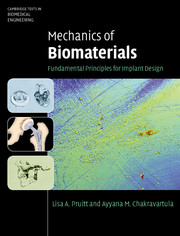Book contents
- Frontmatter
- Contents
- Symbols
- Prologue
- Part I Materials
- Part II Mechanics
- 6 Elasticity
- 7 Viscoelasticity
- 8 Failure theories
- 9 Fracture mechanics
- 10 Fatigue
- 11 Friction, lubrication, and wear
- Part III Case studies
- Epilogue
- Appendix A Selected topics from mechanics of materials
- Appendix B Table of material properties of engineering biomaterials and tissues
- Appendix C Teaching methodologies in biomaterials
- Glossary
- Index
- References
9 - Fracture mechanics
from Part II - Mechanics
Published online by Cambridge University Press: 05 June 2012
- Frontmatter
- Contents
- Symbols
- Prologue
- Part I Materials
- Part II Mechanics
- 6 Elasticity
- 7 Viscoelasticity
- 8 Failure theories
- 9 Fracture mechanics
- 10 Fatigue
- 11 Friction, lubrication, and wear
- Part III Case studies
- Epilogue
- Appendix A Selected topics from mechanics of materials
- Appendix B Table of material properties of engineering biomaterials and tissues
- Appendix C Teaching methodologies in biomaterials
- Glossary
- Index
- References
Summary
How might implants catastrophically fail when experiencing stresses far below the yield or ultimate tensile strength? How could this outcome be affected by material behavior, manufacturing, and quality concerns?
Biomedical implants are often complicated systems with multiple interacting components made of different materials. Thus, designing them successfully to function in the body and not fail even in predictable ways can be difficult. Basic structural analysis can quantify the expected potential of overcoming the strength of the implant under load, but such analyses presume the implant materials to be essentially unflawed or to remain flaw-free prior to global failure. In practice, medical devices fail in more complicated modes than exceeding the strength, and one of the most catastrophic of these modes is fracture. Medical device fractures occur when cracks or sharp flaws cause a local extreme stress that causes material breakdown, even under relatively mild loading conditions. Flaws or cracks can either exist inherently in the material or be caused by manufacturing, which can be mitigated through inspection and quality control. Cracks can also form during loading near sharp notches designed into the component, even if the component is flaw-free. The key is to consider fracture a catastrophic outcome for medical devices, one that could endanger the lives of patients if incompletely understood. The field of fracture mechanics has been developed to prevent such failures in a wide range of materials through analysis, and is very relevant to the design of implanted medical devices.
Overview
The origin of modern fracture mechanics is mainly traced to the contributions and insights of two well-known scientists: A.A. Griffith after the First World War, and G.R. Irwin after the Second. In 1921, Griffith published his results on the wide discrepancy observed between the actual strength of brittle materials and the theoretically obtainable strength (as discussed in Chapter 3). His work showed that reducing the size of glass fibers increased their strength directly according to predictions, nearly achieving the theoretical strength of the material (as described in Chapter 3). The central role of sharp flaws in the strength of materials was established along with the energetic description for the driving force for fracture. In 1948, Irwin evaluated crack tip conditions, and ultimately developed the more engineering-oriented approach of studying the extreme stresses at crack tips, and relating them to simple geometry-independent parameters. The field of fracture mechanics has remained active since that time, investigating more complicated materials and part configurations, but the underlying principles developed by Griffith and Irwin have endured.
- Type
- Chapter
- Information
- Mechanics of BiomaterialsFundamental Principles for Implant Design, pp. 283 - 328Publisher: Cambridge University PressPrint publication year: 2011



